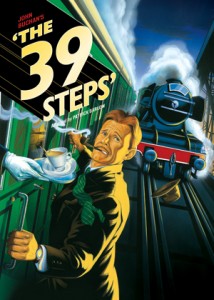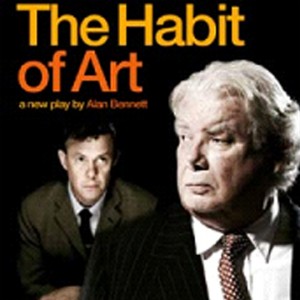September 19th, 2010 · 1 Comment
I have now seen a total of five shows here in London. First, the Merry Wives of Windsor at the Globe Theatre, followed by the Czech Philharmonic concert at Royal Albert Hall, Les Miserables at the Queen’s Theatre, The 39 Steps at the Criterion Theatre, and The Habit of Art at the National Theatre. For this blog post, I will focus on The 39 Steps and The Habit of Art, because I think these shows have certain things in common that are a good demonstration of British culture.
Both shows were distinctly meta-theatrical. In The 39 Steps, costume and set changes happened right on stage and Professor Jordan proclaims the show’s self-consciousness when he is shot by a bodiless arm at the end of the show and shouts “This is supposed to be a four person cast!” The Habit of Art is a play within a play. Better yet, the play within the play is being rehearsed at the National Theatre, where the play is being shown. The rehearsal of Caliban’s Day is frequently interrupted by the actors, the stage manager, and the writer to talk about the trials and tribulations of acting, writing, and theatre. I think that both of these shows’ use of meta-theatre demonstrates the British love of irony and humor, their tendency toward self-consciousness and self-deprecation, and the Importance of Not Being Earnest Rule as defined by Kate Fox. Meta-theatre demonstrates that the show and the playwright are not taking themselves too seriously. When some of the class was talking during intermission, I remember Matt wondering why there couldn’t have just been a play about Auden and Britton, and why they had to go to the trouble of adding all the extra characters and putting it in a frame. He suggested that the playwright was too worried that a serious play about Auden and Britton would not go over well. This theory may be exactly right. A play just about Auden and Britton may have been reviewed with an “Oh come off it” rather than a “deeply and unexpectedly moving” and a “I can think of few plays that combine wild laughter, deep emotion, and technical ingenuity with such bravura” (Charles Spencer, Telegraph, 18 November 2009).

photo credit: Google Images

photo credit: Google Images
This is still just a theory. As a sidenote, I do think the framing had its merits. Caliban’s Day is about the pressure to create art, the artist’s consciousness of his role and reputation as an artist, and the contriving that goes on behind the scenes with the artist’s fear of biographical information seeping into or being read into his art. The insecure actors and writer and the ever-comforting and conciliatory stage manager are a parallel story to Auden’s and Britton’s, allowing the themes to be developed more deeply and thoroughly, applying them to theatre as well as poetry and music.
We have talked about theatre in London as being a sort of equalizer. Anyone who can afford even fifteen pounds can get a pretty good seat for a show. In the National Theatre, there are no restricted view seats nor are there any boxes. Everyone is on the same footing, and to demonstrate this, we got to sit in the same row as Sir Ian McKellen at The Habit of Art. While all of this is true, I still felt like a bit of an outsider at both of these shows. I really enjoyed The 39 Steps, but I still had some trouble catching all of the jokes, even after having read Fox and lived in London for a month. Many of the jokes, such as the jokes about Welsh politics and the “sorry, sorry, sorry” sequence on the train are distinctly British, and not fully accessible to us foreigners. The same held true with the humor in The Habit of Art. I’m not complaining; I’m sure American movies and plays present the same problems to the British. I do think I have a point though, in saying that the content in The Habit of Art was not accessible to just anyone. I think in order to fully understand the play, you needed a reasonable understanding of theatre and its operations (in this respect our backstage tour helped a lot) and an understanding of Auden’s biography, his poetry and The Tempest. It took me probably until close to intermission to grasp who all the characters were and the plotlines of both stories. I think the play was rather intellectual, despite containing much crude humor, and perhaps did not quite match the humble and universally accessible National Theatre.
Tags: 2010 Kaitlin
September 14th, 2010 · 1 Comment
When President Durden asked us whether we had seen any aspects of London that changed our views of what we want from life, I, like many others, thought of the fantastic access to the arts here. This has been manifested for me in all of the free museums and especially in the reasonable prices of theatre tickets on the West End. I came to London knowing that I wanted to go the theatre as much as possible, and I set aside a significant portion of my meager summer earnings (unpaid internship–ouch) for that purpose. I’ve been lucky enough to see five shows in London so far: The Merry Wives of Windsor, Billy Elliot, Bedlam, Les Miserables, and The 39 Steps. Although I sat in the very back row of the theatre for Les Mis and had a railing in my line of sight during Billy Elliot, I was able to purchase tickets for twenty pounds and twenty-seven pounds, respectively. If I tried to see so many shows, especially big name musicals, in the States, I would probably have no money left, so that’s been really fantastic.
I’m fairly predisposed to like theatre productions (I kind of enjoyed Bedlam, actually), but since hearing Rick Fisher speak I’ve started to evaluate the nature of the shows that I’ve seen differently, especially the two musicals. Les Miserables and Billy Elliot both draw in a lot of tourists, but I had very different reactions to these two shows. Les Mis is an epic show; there’s no other way to say it. It’s full of famous numbers that showcase the performers’ abilities to belt out big choruses and really high notes, one song after another. There are incredible set pieces and dramatic lighting cues up the wazoo. It’s an extremely showy piece. I don’t want to call it glitzy because so much of the drama comes from the violent deaths of various characters, but I think that it’s very aware of what audiences want. This is not a bad thing at all, and it certainly seems to have worked for the production. Personally, though, I found it hard to connect with the emotion of the show because I was just waiting for the next show-stopping number and Rick Fisher’s voice was in the back of my head. I thought that it was indulgent and Hollywood-esque, and once or twice I thought, “So these are a bunch of British actors performing in a show that aks me to glorify France…what?” I had trouble connecting with the show, although I did enjoy it.
Part of my reaction may have stemmed from the fact that I had just seen Billy Elliot, which I absolutely fell in love with. Unlike Les Mis, Billy Elliot doesn’t focus on showstoppers so much. I didn’t feel like it was trying to be anything that it wasn’t–it was a more honest story. Although it doesn’t have the violence of Les Mis, it’s a grittier play because there aren’t gorgeous sets or big songs for performers to belt out. The show focuses more on telling the story at hand, the story of a young boy struggling to be himself amidst the coal strikes in northern Engalnd during the Thatcher era. Because it wasn’t as pretty as Les Mis, I thought that the emotions communicated in Billy Elliot were more raw and easier to conncet with, to the point that I shed some tears during a few points in the performance.
The honesty that I loved in Billy Elliot was definitely embodied in this afternoon’s performance of The 39 Steps, which I loved. To work as a spoof, the show had to be completely aware of where it was coming from, and it also couldn’t pretend to be anything bigger than it was. I thought that the show successfully took on not only the Hitchcock movie, but also theatre and Englishness in general. It was almost as though Kate Fox was consulted on the rules of Englishness while the play was being adapted. Think of the two men in the train who were constantly saying, “‘Scuse me, sorry! Sorry, ‘scuse me!” The entire show was about being able to laugh at oneself and at the national character. Based on Kate Fox’s descriptions, I thought that it was just so English. And we saw it in a beautiful, intimate theatre, which definitely contributed to the atmosphere. I thought that it was hilarious and very well-performed.
So, Les Mis disciples, please don’t hate me because I really enjoyed that show, but I found the emotional and/or comedic honesty of the other two shows more easily accessible.
Tags: 2010 Holly · Theatre


